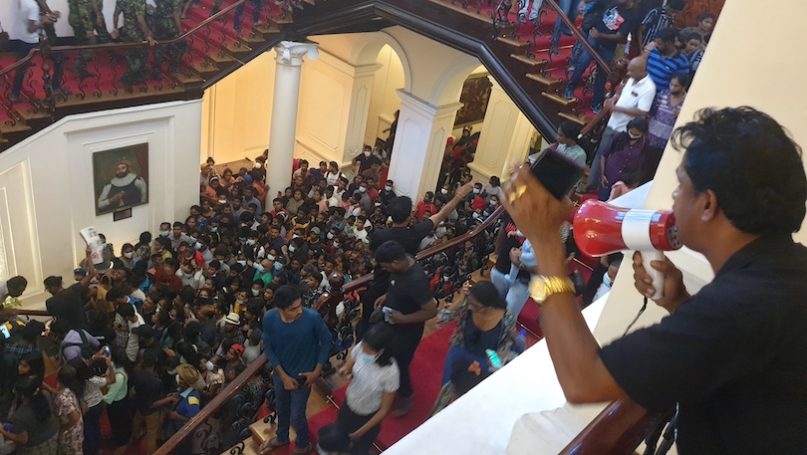Opinion – The Demise of the Rajapaksa Dynasty and Prospects for Peace and Justice in Sri Lanka

On 9 July 2022, Sri Lankan President Gotabaya Rajapaksa agreed to step down from the presidency amid widespread protests in Colombo. On 13 July he fled to the Maldives on a military jet and went to Singapore on the following day. In Singapore he tendered his resignation first by email and then by diplomatic post. Prime Minister Ranil Wickremesinghe was sworn in as acting president on 15 July. The Sri Lankan parliament is set to elect a new president on 20 July to serve for the rest of the current term. Sajith Premadasa, Leader of the Opposition, is expected to run for the position. Rajapaksa’s departure effectively represents the end of a 13-year (2005-15; 2019-22) regime held by his family.

This is the culmination of rising tensions which have been building up over years (not months, as explained below). Before this pivotal moment in July, the government had declared the state of emergency on 1 April and, after the resignation of most of the cabinet, Mahinda Rajapaksa (Gotabaya’s elder brother and former president in 2005-15) had resigned as Prime Minister on 9 May.
The immediate cause of the current turmoil in Sri Lanka is the worst economic crisis since independence. Because of fuel shortages, the government has had to ban petrol sales to private citizens, while prizes of food keep rising. On 10 June, the United Nations Office for the Coordination of Humanitarian Affairs (UN OCHA) even warned that the Sri Lankan government would risk “a full-blown humanitarian emergency” because of the lack of food and medicines. Although the accusation that China has employed ‘debt trap diplomacy’ in Sri Lanka is open to dispute, the borrowings incurred by the Chinese Belt and Road Initiative (BRI) infrastructure projects, especially those in the southern hometown of the Rajapaksa family, have worsened its already precarious economic situation.
On 18 May 2022, for the first time in the country’s history, Sri Lanka failed to pay $78m in interest on two sovereign bonds. According to the International Monetary Fund, Sri Lanka’s foreign debt stands at $38.6 billion, of which 10% is owed to Chinese creditors. On the surface, the share is not high; however, the terms of Chinese loans are clouded by non-transparency with an estimate saying that the real share is 19.9%.
The Rajapaksa regime has inflicted a more severe damage on the country: domestic peace and justice. The new government will have to deal with the longstanding problems of Sinhalese-Buddhist ethno-religious nationalism and the unresolved struggle for accountability for the crimes committed during the 26-year-long civil war (1983-2009) between the Government of Sri Lanka and the Liberation Tigers of Tamil Eelam (LTTE), commonly knowns as the Tamil Tigers. Sinhalese-Buddhists believe that they are Buddha’s chosen people, and war against others (e.g. Tamils and Muslims) to defend Sinhalese-Buddhism is legitimate. The Rajapaksa regime was indeed built on an ultra-exclusive form of ethno-religious nationalist and triumphalist rhetoric which glorified the government for putting an end to the civil war, without acknowledging the numerous war crimes committed at the time.
The civil war was fundamentally anchored onto the longstanding discrimination against the Tamil minority, in the northern and eastern part of Sri Lanka. According to the Office of the United Nations High Commissioner for Human Rights (OHCHR), both sides to the conflict, especially the government army, had committed serious breaches of international law, allegedly amounting to war crimes, notably during the final stages of the war in 2009. The UN Human Rights Council’s Resolution 46/1, passed on 23 March 2021, called on the Sri Lankan government to fulfill its international legal duty to investigate any alleged human rights abuses committed during the war and prosecute any culpable individuals. These calls have, however, been largely ignored.
The only glimpse of accountability that was provided by the Sri Lankan government was through the Lessons Learnt and Reconciliation Commission (LLRC), headed by Mahinda Rajapaksa. The LLRC, however, was faulty in its mandate and results as it only provided a partial account of the human rights violations committed during the war and actually praised the government for avoiding civilians, thus deflecting criticisms away from the government and the military by blaming the LTTE. This did not come as a surprise to external observers, because Gotabaya was then the Defence Secretary.
Despite the appalling economic situation affecting all of the Sri Lankan population, in Tamil-dominated areas the major problem still lies in the lack of justice and the alienation of this group from the political life of the country. For fears of reprisals by Sinhalese-Buddhist, Tamils have therefore not joined the anti-Rajapaksa protests. Not only Tamils, Muslims have also become targets of intolerance and hate campaigns in recent years. The Sri Lankan population is therefore far from united and economic struggles are just one of the notable challenges facing the country. Impunity, widespread injustices, and the failure of providing the country with transitional justice are major obstacles to Sri Lanka’s search for durable peace and stability.
While the most pressing concern for the next government is certainly economic recovery, the bigger question is whether the new leaders, like the Rajapaksas, will still rely on Sinhalese-Buddhist ethno-religious nationalism to rule the country or finally ensure postwar accountability. Besides the rise of individual autocratic political leaders, ethno-religious nationalism has led to illiberal populism and democratic regression in Sri Lanka.
As Sri Lanka is seeking a bailout from the IMF rather than China, the international community has a role to play in pressing the new government to pursue inter-ethnic reconciliation and transitional justice. However, whether the new president is committed to it is debatable, as the father of Sajith Premadasa, Ranasinghe Premadasa, former President in 1989-1993, was believed to be assassinated by the LTTE.
Further Reading on E-International Relations
- Sri Lanka’s Economic Crisis: The Chinese Model in Operation
- Walking the Reflexive Talk
- Opinion – Escalating Conflict Endangers Prospects of Peace in Yemen
- Opinion – China’s Belt and Road Initiative: Pragmatism over Morals?
- A New Taliban Leadership and Peace Prospects in Afghanistan
- Opinion – The ICC and Non-State Actors in the Xinjiang Crisis
No comments:
Post a Comment